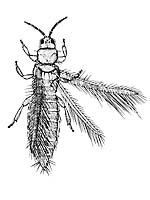|
The next order, Thysanoptera, includes individuals commonly referred to as "thrips." The term "thrips" is both singular and plural. In other words, there is no insect called a "thrip." In terms of important species, the western flower thrips, gladiolus thrips, and pear thrips are three species that may be encountered in landscapes.
These individuals are examples of a transitional condition between gradual and complete metamorphosis. Thrips develop from an egg, to larval stage, and molt into prepupal and a pupal stage prior to becoming an adult.
Thrips are somewhat unique developmentally, and thus, we describe them as being indicative of having both complete and gradual types of metamorphosis. They have two pairs of fringed wings (check the illustration associated with this order). Thrips are not known to be strong fliers.
If you check older entomological references you may find that thrips are described as having rasping-sucking mouthparts, but we now know them to have piercing-sucking mouthparts.
One of the key features of members in this order is that their tarsi are bladder-like at the tip. That is, thrips have swollen areas associated with the very end of their legs.
We know that there are about 4,000 different species worldwide with about 700 species of thrips known to occur in North America north of Mexico. |

Thrips
Order: Thysanoptera
Family: Thripidae
|
